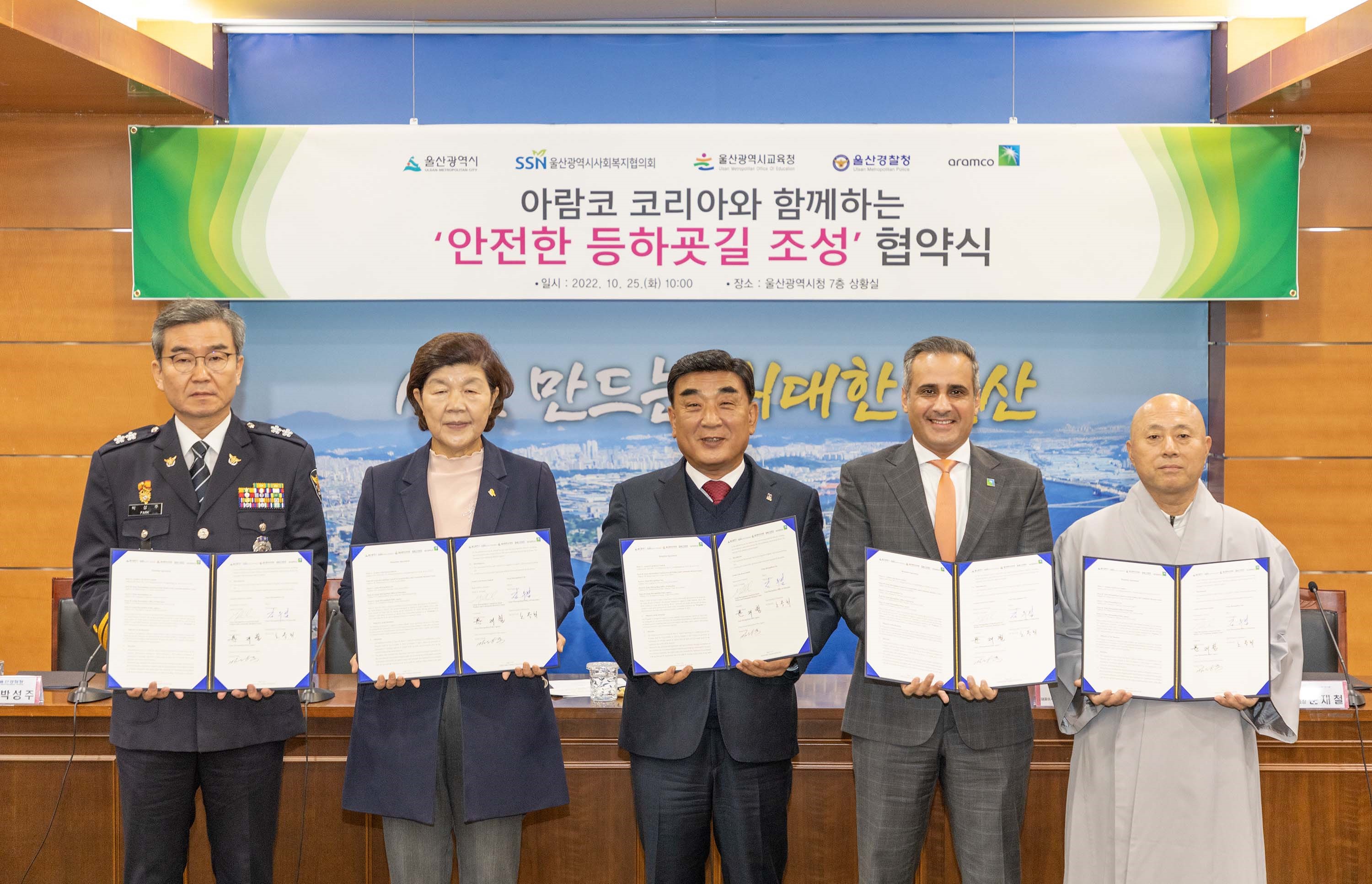아람코 코리아, 울산시 스쿨존 교통안전 프로그램 지원 2년째 이어가

(사진 왼쪽부터) 울산시청에서 열린 ‘안전한 등하굣길 조성 (Safer Routes to School)’ 협약식에서 박성주 울산시경찰청장, 노옥희 울산시 교육감, 김두겸 울산시장, 무티브 알 하비 아람코 코리아 대표이사, 문재철 울산사회복지협의회장이 협약식 체결 후 기념촬영을 하고 있다.
아람코의 한국법인 아람코 코리아 (대표이사 무티브 알 하비)가 울산시 스쿨존 내 교통 안전 프로그램 지원 협약식을 체결했다.
이번에 체결한 '안전한 등하굣길 조성 (Safer Routes to School)' 프로그램은 아람코 코리아가 지난해부터 울산시·울산사회복지협의회·울산광역시교육청·울산경찰청과의 협업을 통해 추진해오고 있는 사회공헌활동 프로그램이다.
울산사회복지협의회 주관으로 추진되고 있는 이 프로그램을 통해 등하교 시 교통안전에 대한 학생들의 인식 고취를 위한 안전교육 프로그램을 실시하고, 스쿨존 내에 속도 제한표시판, 옐로 카펫 등의 교통안전 시설물을 설치해 운전자들의 안전 운전을 지원하게 된다. 지난해 이 프로그램을 통해 울산시 50개 학교의 약 5,000여 명의 학생들이 혜택을 받았으며 올해도 약 5,500여 명의 학생들이 도움을 받게 될 예정이다.
25일 울산광역시청에서 열린 협약식에는 무티브 알 하비 아람코 코리아 대표이사, 김두겸 울산시장, 노옥희 울산시 교육감, 박성주 울산시경찰청장, 문재철 울산사회복지협의회장 등 주요 관계자들이 참석했다.
협약식에서 무티브 알 하비 아람코 코리아 대표이사는 “아람코 코리아가 이 스쿨존 교통안전 프로그램을 지속 지원하고 이를 통해 학생들이 보다 더 안전하게 학업에 전념할 수 있도록 도움을 줄 수 있어 자부심을 느낀다. 또한 이 교통안전 프로그램을 시작한 이후로 타 기업들도 스쿨존 교통안전을 위해 동참해오고 있다는 사실을 기쁘게 생각하며, 많은 이들에게 도움이 되는 이 프로그램을 위해 함께 해주고 계신 파트너 기관들에게 감사의 말씀을 드린다.”라고 밝혔다.
김두겸 울산시장은 “지난해에 이어 뜻깊은 프로그램에 아람코 코리아가 도움을 주셔서 감사하다”며 “울산의 미래인 아동들이 더욱더 안전하게 학교에 다닐 수 있는 환경이 조성될 수 있도록 시에서도 각별한 관심을 가지고 아낌없이 지원하도록 하겠다.” 라고 밝혔다.
문재철 울산사회복지협의회 회장은 “운전자와 학생들의 교통안전 인식을 증진하고 이를 통해 사고 발생률을 줄이기 위해서는 이번 프로그램과 같은 프로그램들이 중요하다. 아람코의 지속적인 지원에 감사드리며 울산시 등하굣길이 보다 더 안전할 수 있도록 지속적이며 통합된 노력을 만들어 나갈 것이다.”라고 덧붙였다.
에쓰오일 최대주주이자 현대오일뱅크의 2대 주주인 아람코는 국내 주요 기업들 및 연구기관과 상호 간 이익이 되는 다양한 사업 및 기술 협력을 발굴·추진해 오고 있다.
또한 코로나19극복 지원을 위한 기부, 장애대학생 대상 장학금 지원, 미세먼지로부터 아이들을 지키기 위해 지역사회 학교에 묘목 식재 지원 및 마스크, 손소독제 등으로 구성된 건강지킴이세트 배부 등 지역사회를 위한 다양한 사회공헌활동을 이어오고 있다.
특히 자회사인 에쓰오일의 주요 생산설비가 위치한 울산지역에서는 2020년부터 초등∙중학생들 대상 코딩 교육 기부 활동도 지원하고 있다.

